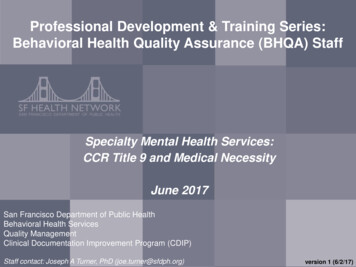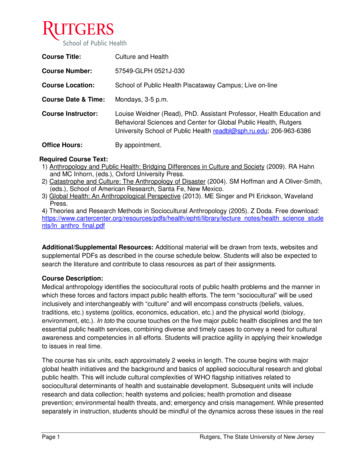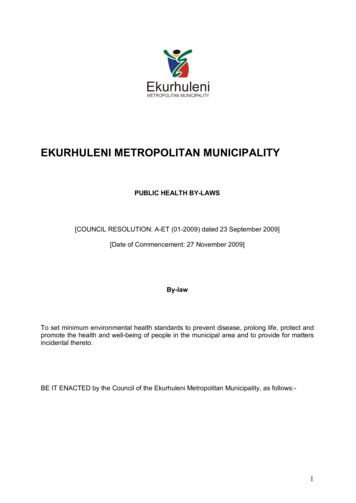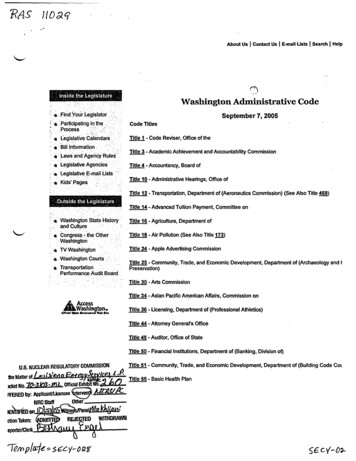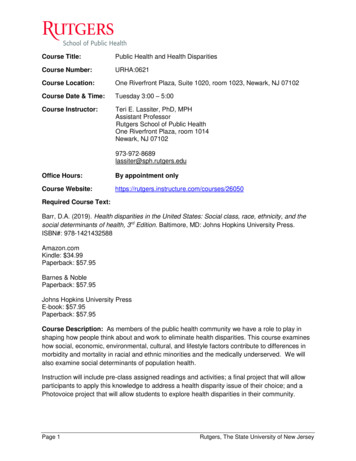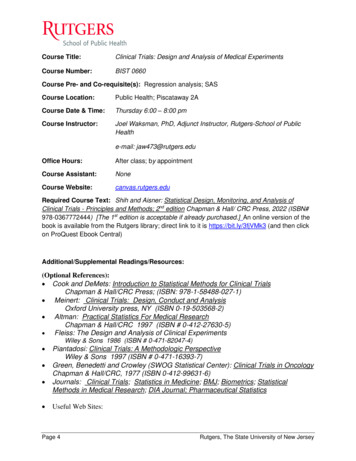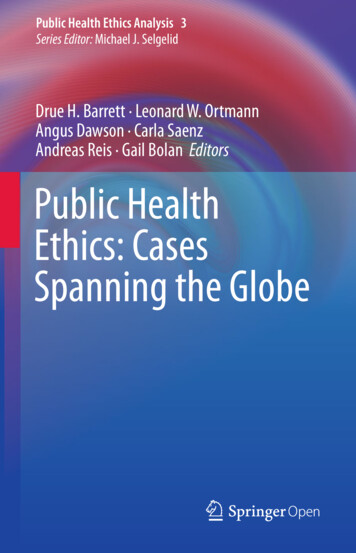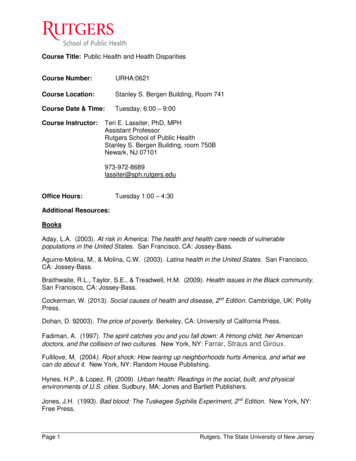
Transcription
Course Title: Public Health and Health DisparitiesCourse Number:URHA:0621Course Location:Stanley S. Bergen Building, Room 741Course Date & Time:Tuesday; 6:00 – 9:00Course Instructor:Teri E. Lassiter, PhD, MPHAssistant ProfessorRutgers School of Public HealthStanley S. Bergen Building, room 750BNewark, NJ 07101973-972-8689lassiter@sph.rutgers.eduOffice Hours:Tuesday 1:00 – 4:30Additional Resources:BooksAday, L.A. (2003). At risk in America: The health and health care needs of vulnerablepopulations in the United States. San Francisco, CA: Jossey-Bass.Aguirre-Molina, M., & Molina, C.W. (2003). Latina health in the United States. San Francisco,CA: Jossey-Bass.Braithwaite, R.L., Taylor, S.E., & Treadwell, H.M. (2009). Health issues in the Black community.San Francisco, CA: Jossey-Bass.Cockerman, W. (2013). Social causes of health and disease, 2nd Edition. Cambridge, UK: PolityPress.Dohan, D. 92003). The price of poverty. Berkeley, CA: University of California Press.Fadiman, A. (1997). The spirit catches you and you fall down: A Hmong child, her Americandoctors, and the collision of two cultures. New York, NY: Farrar, Straus and Giroux.Fullilove, M. (2004). Root shock: How tearing up neighborhoods hurts America, and what wecan do about it. New York, NY: Random House Publishing.Hynes, H.P., & Lopez, R. (2009). Urban health: Readings in the social, built, and physicalenvironments of U.S. cities. Sudbury, MA: Jones and Bartlett Publishers.Jones, J.H. (1993). Bad blood: The Tuskegee Syphilis Experiment, 2nd Edition. New York, NY:Free Press.Page 1Rutgers, The State University of New Jersey
Landale, N.S., McHale, S., & Booth, A. (2010). Growing up Hispanic: Health and developmentof children of immigrants. Lanham, MD: Rowman & Littlefield Publishers.LaVeist, T.A., & Isaac, L.A. (Eds.). (2013). Race, ethnicity, and health (Second Edition). SanFrancisco, CA: Jossey-Bass.Massey, D.S., & Denton, N.A. (1994). American apartheid: Segregation and the making of anunderclass. Cambridge, MA: Harvard University Press.Portes, A., & Rumbaut, R.G. (2001). Legacies: The story of the immigrant second generation.Berkeley, CA: University of California Press.Sampson, R.J. (2012). Great American city: Chicago and the enduring neighborhood effect.Chicago, IL: University of Chicago Press.Smedley, B.D., Stith, A.Y., & Nelson, A.R. (Eds.) (2003). Unequal treatment: Confronting racialand ethnic disparities in health care. Washington, DC: National Academies Press.Shi, L., & Stevens, G.D. (2010). Vulnerable populations in the United States. San Francisco,CA: Jossey-Bass.Skloot, R. (2011). The immortal life of Henrietta Lacks. New York, NY: Broadway Books.Trinh-Shevrin, C., Islam, N.S., & Rey, M.J. (2009). Asian American communities and health.San Francisco, CA: Jossey-Bass.Wilson, W.J. (2010). More than just race: Being Black and poor in the inner city. New York, NY:W.W. Norton & Company.ReportsCenters for Disease Control. (2013). CDC health disparities and inequalities report – UnitedStates, 2013. MMWR, 62(Suppl 3). 1-187. Retrieved stitute of Medicine (IOM). (2011). The health of lesbian, gay, bisexual, and transgenderpeople: Building a foundation for better understanding. Washington, DC: The NationalAcademy Press. Retrieved from ad, H., Cartwright-Smith, L., Jones, K., Ramos, C., Woods, K., & Siegel, B. (2008). Racialand ethnic disparities in U.S. health care: A chartbook. The Commonwealth Fund. Retrievedfromhttp://www.commonwealthfund.org/usr doc/mead racialethnicdisparities chartbook 1111.pdfSeith, D., & Isakson, E. (2011). Who are America’s poor children? Examining health disparitiesamong children in the United States. National Center for Children in Poverty. Retrieved fromhttp://www.nccp.org/publications/pdf/text 995.pdfPage 2Rutgers, The State University of New Jersey
US Department of Health and Human Services (2015). 2014 National Healthcare Quality andDisparities Report. AHRQ Publication No. 15-0007. Retrieved bsitesAffordable Care Act. http://www.hhs.gov/healthcare/rights/Healthy People 2020. http://www.healthypeople.gov/National Library of Medicine: Health disparities. fice of Minority Health. http://minorityhealth.hhs.gov/Course Description: As members of the public health community we have a role to play inshaping how people think about and work to eliminate health disparities. This course examineshow social, economic, environmental, cultural and lifestyle factors contribute to differences inmorbidity and mortality in racial and ethnic minorities and the medically underserved. We willalso examine social determinants of population health.Instruction will include pre-class assigned readings and activities; a final project will allowparticipants to apply this knowledge to a communications challenge of their choice.Selected Department Competencies Addressed: Identify the health status of U.S. urban populations and their related determinants;Identify the main issues that affect the organization, financing, and delivery of healthservices, and public health systems in urban communities, especially among disadvantagedpopulationsPlease visit the Department webpages on the School of Public Health’s website athttp://sph.rutgers.edu/ for additional competencies addressed by this course for other degreesand departments.Course Objectives: By the completion of this course, students will be able to: Page 3To understand the historical development of systems of racial classification and their usein scientific inquiry and public policy.Articulate complex relationships between race, socioeconomic status, psychosocial andcultural factors and how these relationships underlie health disparities.Assess the impact of health care access and quality on health status and healthdisparities.To examine potential strategies for better understanding health disparities and workingtoward health equity.Rutgers, The State University of New Jersey
Course Requirements and Grading:MoodleUpon registration for this course, you will have access to Moodle.1. Go the Moodle site: moodle.rutgers.edu2. Log-in using your Rutgers University ID and password.3. Take the Moodle Student Tutorials.You are required to take the Moodle Student Tutorials so that you are prepared for the course.All of the course materials will be posted on the Moodle site, including the syllabus and slides.You will be required to print all materials prior to class; no handouts will be provided by theinstructor.AssignmentsWeekly ArticlesWeekly reading assignments are listed on the course syllabus. Links have been provided for allarticles, reports, and websites that are required for the weekly reading assignments. If youdiscover that one of the links is not working, please notify me immediately. The links werecurrent as of August 31, 2016.Consider the following as you complete the readings so that you are prepared to discuss themin class:1.2.3.4.5.What are the main questions the author is posing?What is the methodology?What are the main conclusions?Do you agree or disagree with the conclusions?What additional questions does the article raise?Article ReviewsYou will be required to submit 2 article summaries during the semester. These summaries cancome from the list of articles that is provided for this course or articles that you have chosen.The summaries should address the following:1. What is the purpose of the paper? What is the underlying research question/hypothesis?2. What is the target group of interest in the study? How is the target population defined? Isthis done in a satisfactory manner?3. What is the methodology used to answer the research question? Is it adequate?Page 4Rutgers, The State University of New Jersey
4. What are the study findings? What ate the conclusions of the authors? Do you agree ordisagree? Why or why not?5. Provide any additional comments of critiques of the article.These article reviews are limited to 750 words, excluding your name, date, and bibliographicinformation about the article. You are required to submit your summaries through Moodle; the email date stamp will determine is the submission deadline has been met. Late papers and/orpapers exceeding the 750 word limit will be penalized a minimum of 5 points.These assignments are to be submitted no later than 5:00 on the due dates. Reminders withthe due dates will be included in the course syllabus. Collaboration and/or assistance fromanother person are not permitted. These assignments will be cross checked using Turnitin.Semester ProjectEach student will be required to select one issue associated with health disparities (i.e.asthma, food insecurity, neighborhood conditions) to research during the semester.Topics will be selected during the second class to allow you ample time to research yourissue and prepare your assignments.This project will take place in two stages: an annotated bibliography and a Powerpointpresentation.Assignment 1: Annotated Bibliography (due Week 5)You are required to submit an annotated bibliography using 25 articles An annotated bibliography is a list of citations to books, articles, and documents. A review of the literature on a particular subjectEach citation is followed by a brief (usually about 150 words) descriptive andevaluative paragraph, the annotation.The purpose of the annotation is to inform the reader of the relevance, accuracy,and quality of the sources cited.(How to Prepare an Annotated Bibliography: The Annotated otatedbibliography)Assignment 2: Powerpoint Presentation (due Week 11)Each student will be required develop a 10-minute Powerpoint presentation discussingwhy the issue chosen is considered a health disparity and how affects the variousgroups that we have discussed in class. You must also be prepared to lead the classdiscussion on your topic.QuizzesCompletion of all weekly readings is required. You will need to complete the readings prior toclass and complete the quizzes covering that material. Quizzes will be posted every other weekbeginning in Week 3. Each quiz will be available for one week and will close at 12 noon on thePage 5Rutgers, The State University of New Jersey
day of class. The purpose of these quizzes is to insure that you have completed the readingassignments which will help you better understand the material and so that you are prepared toparticipate during each class.You are required to complete each quiz prior to class.All readings are mandatory and must be read prior to each class. Lectures are not meantto substitute the reading materials.Class ParticipationStudents are expected to attend class and to have completed the reading before each class sothat we can engage in an intellectual discussion about the current topic area. Class participationincludes attendance, completing course reading prior to class (this will partially be determinedby the weekly quizzes), and participation in class discussions.GradingArticle reviews (2)QuizzesSemester ProjectAnnotated bibliographyPowerpoint presentationFinal exam20%20%20%10%30%Course Schedule:TopicCourse OverviewIntroduction toHealth DisparitiesThe Meaning ofRace/EthnicityPage 6Assigned ReadingsWeek 1noneAssignmentsComplete thereading assignmentsfor Week 2.Week 2Articles:Hebert, P.L., Sisk, J.E., & Howell. E.A. (2008). When does adifference become a disparity? Conceptualizing racial andethnic disparities in health. Health Affairs, 27(2), 7/2/374.full.pdf htmlWeek 3Articles:Byrd, W.M., & Clayton, L.A. (2003). Racial and ethnicdisparities in healthcare: A background and history. In NationalResearch Council (Ed.), Unequal treatment: Confronting racialand ethnic disparities in health care (pp. 455-527).Washington, DC: The National Academies Press.http://www.nap.edu/catalog/10260.html (click on hyperlinkchoose “Download Free PDF,” select “Download PDF(Chapters)” and open the assignment.Complete thereading assignmentsfor Week 3.Complete thereading assignmentsfor Week 4 and Quiz1.Rutgers, The State University of New Jersey
SocialDeterminants ofHealthKawachi, I., Daniels, N., & Robinson, D.E. (2005). Healthdisparities by race and class: Why both matter. Health Affairs,24(2), 4/2/343.full.pdf htmlWeek 4Articles:Arcaya, M.C., Subramanian, S.V., Rhodes, J.E., Waters, M.C.(2014). Role of health in predicting moves to poorneighborhoods among Hurricane Katrina survivors.Proceedings of the National Academy of Sciences of the UnitedStates of America, 111(46), 46.full.pdfComplete thereading assignmentsfor Week 5.Braveman, P.A., Egerter, S.A., & Mockenhaupt, R.E. (2011).Broadening the focus: The need to address the socialdeterminants of health. American Journal of PreventiveMedicine, 40(1S1), S4-S18. 9379710005635main.pdf? tid 253c3192-dee8-11e4-a54100000aab0f02&acdnat 1428605116 98bb5d771bae75a51bfe79c67561b795SocialDeterminants ofHealth SocioeconomicsBraveman, P., & Gottlieb, L. (2014). The social determinants ofhealth: It’s time to consider the causes of the causes. PublicHealth Reports, 129(Supp. 2), .cfm?articleID 3078Week 5Articles:Woolf, S.H., & Braveman, P. (2011) Where health disparitiesbegin: The role of social and economic determinants – and whycurrent policies may make matters worse. Health Affairs,30(10), /30/10/1852.full.pdf htmlReports:Robert Wood Johnson Foundation, Commission to Build aHealthier America. (2011). Exploring the social determinants ifhealth – 2011. Issue Brief 4: Income, wealth and s/issue ts ofHealthPage 7Robert Wood Johnson Foundation, Commission to Build aHealthier America. (2011). Exploring the social determinants ofhealth. Issue Brief 6: Race, socioeconomic factors and s/issue briefs/2011/rwjf70446Week 6Articles:Lara, M., Gamboa, C., Kahramanian, M.I., Morales, L.S., &Bautista, D.E. (2005). Acculturation and Latino health in theUnited States: A review of the literature and its sociopoliticalcontext. Annual Review of Public Health, 26, 367-397.Complete thereading assignmentsfor Week 6 and Quiz2.Semester ProjectAssignment 1 due.Complete thereading assignmentsfor Week 7.Rutgers, The State University of New Jersey
ev.publhealth.26.021304.144615SocialDeterminants ofHealthNeighborhoods,Housing and HealthSalant, T., & Lauderdale, D.S. (2003). Measuring culture: Acritical review of acculturation and health in Asian immigrantpopulations. Social Science & Medicine, 57, .0S0277953602003003-main.pdf? tid edbc8054-ded9-11e480f600000aab0f6b&acdnat 1428599010 266ce2239979dfce6b2db35d5a255219Week 7Video:A Place at the Table (in class)Articles:Bodor, J.N., Rose, D., Farley, T.A., Swalm, C., Scott, S.K.(2007). Neighbourhood fruit and vegetable availability andconsumption: The role of small food stores in an urbanenvironment. Public Health Nutrition, 11(4), d%20F%20and%20V%20availability%20and%20consumption nv.pdfComplete thereading assignmentsfor Week 8 and Quiz3.First Article Reviewdue.Walker, R.E., Keane, C.R., & Burke, J.G. (2010). Disparitiesand access to healthy food in the United States: A review offood deserts literature. Health & Place, 16(5), le/pii/S1353829210000584SocialDeterminants ofHealthNeighborhoods,Housing and HealthZachary, D.A., Palmer, A.M., Beckham, S.W., & Surkan, P.J.(2013). A framework for understanding grocery purchasing in alow-income urban environment. Qualitative Health Research,23(5), 665-678. Retrieved df htmlWeek 8Articles:Kelling, G.L. & Wilson, J.Q. (1982). Broken windows. TheAtlantic Monthly, 249(3), 29-38. Retrieved 82/03/brokenwindows/304465/Complete thereading assignmentsfor Week 9.Speaker: JackFarrellStewart, E.A., & Simons, R. L. (2010). Race, code of thestreet, and violent delinquency: A multilevel investigation ofneighborhood street culture and individual norms of violence.Criminology, 48(2), /j.17459125.2010.00196.x/epdfReports:Robert Wood Johnson Foundation, Commission to Build aHealthier America. (2011). Exploring the social determinants ifhealth. Issue Brief 7: Housing and Health.Page 8Rutgers, The State University of New Jersey
http://www.rwjf.org/content/dam/farm/reports/issue briefs/2011/rwjf70451Robert Wood Johnson Foundation, Commission to Build aHealthier America. (2011). Exploring the social determinants ifhealth series. Issue Brief 8: Neighborhoods and s/issue briefs/2011/rwjf70450At Risk PopulationsMinoritiesWomen andChildrenImmigrantsLGBTQIRobert Wood Johnson Foundation, Commission to Build aHealthier America. (2011). Exploring the social determinants ifhealth series. Issue Brief 10: Violence, social disadvantage orts/issue briefs/2011/rwjf70452Week 9Articles:Chung, E.K., Siegel, B.S., Garg, A., Conroy, K., Gross, R.S.,Long, D.A., Fierman, A.H. (2016). Screening for socialdeterminants of health among children and families living inpoverty: A guide for clinicians. Current Problems in Pediatricand Adolescent Health Care, 46(5), le/pii/S1538544216000341Complete thereading assignmentsfor Week 10 andQuiz 4.Kirby, J.B., & Kaneda, T. (2013). ‘Double jeopardy’ measuresuggests Blacks and Hispanics face more severe disparitiesthan previously indicated. Health Affairs, 32(10), /32/10/1766.full.pdf htmlMcGuire, T.G., & Miranda, J. (2008). New evidence regardingracial and ethnic disparities in mental health: Policyimplications. Health Affairs, 27(2), 7/2/393.full.pdf htmlPriest, N., Paradies, Y., Trenerry, B., Truong, M., Karlsen, S., &Kelly, Y. (2013). A systematic review of studies examining therelationship between reported racism and health and wellbeingfor children and young people. Social Science & Medicine, ticle/pii/S0277953612007927At Risk Populationscont.Page 9Probst, J.C., Bellinger, J.D., Walsemann, K.M., Hardin, J., &Glover, S.H. (2011). Higher risk of death in rural Blacks andWhites than urbanites is related to lower incomes, education,and health coverage. Health Affairs, 30(10), /30/10/1872.full.pdf htmlWeek 10Articles:Cahill, S., & Makadon, H. (2014). Sexual orientation andgender identity data collection in clinical setting and inelectronic health records: A key to ending LGBT healthGuest Speaker: PhilMcCabeRutgers, The State University of New Jersey
disparities. LGBT Health, 1(1), /lgbt.2013.0001Castaneda, H., Holmes, S.M., Madrigal, D.S., Young, M.D.,Beyeler, N., & Quesada, J. (2015). Immigration as a socialdeterminant of health. Annual Review of Public Health, .1146/annurevpublhealth-032013-182419Lu, W., Diep, C.S., & McKyer, E.L.J. (2015). Risk factors forchildhood obesity among Asian Americans: A systematicreview of literature and recommendations for health careresearch. Journal of Health Care for the Poor andUnderserved, 26(2), 171-190.http://muse.jhu.edu/journals/journal of health care for the poor and underserved/v026/26.2A.lu.htmlMollon, L. (2012). The forgotten minorities: Health disparitiesof the Lesbian, Gay, Bisexual, and Transgenderedcommunities. Journal of Health Care for the Poor andUnderserved, 23(1), 1-6.http://muse.jhu.edu/journals/journal of health care for the poor and underserved/v023/23.1.mollon.pdfSingh, G.K., Rodriguez, A., & Kogan, M.D. (2013). Immigranthealth inequalities in the United States: Use of eight majornational data systems. The Scientific World /512313/abs/Week 11Student presentationsQuiz 5.Semester ProjectAssignment 2 due:PowerpointPresentationsSecond ArticleReview due.Access toCare/HealthServicesWeek 12Articles:Mitchell, F.M. (2015). Racial and ethnic health disparities in anera of health care reform. Health & Social Work, 40(3), e66.full.pdf htmlSealy-Jefferson S., Vickers, J., Elam, A., & Wilson, M.R.(2015). Racial and ethnic health disparities and the AffordableCare Act: A status update. Journal of Racial and Ethnic HealthDisparities. -0113-zComplete thereading assignmentsfor Week 14 andQuiz 6.Speaker: TonyaCook, DMDReports:Doty, M.M., Abrams, M.K., Hernandez, S.E., Stremikis, K., &Beal, A.C. (2010). Enhancing the capacity in community healthPage 10Rutgers, The State University of New Jersey
centers to achieve high performance. The CommonwealthFund.http://www.commonwealthfund.org/ /media/files/publications/fundreport/2010/may/1392 doty enhancing capacity community hlt ctrs 2009 fqhc survey v5.pdfNational Association of Community Health. (2007). Accessdenied: A look at America’s medically nts/research/Access Denied42407.pdfSchoen, C., Hayes, S.L., Collins, S.R., Lippa, J.A., & Radley,D.C. (2014). America’s uninsured: A state-by-state look athealth insurance affordability prior to the new coverageexpansions. The Commonwealth Fund.http://www.commonwealthfund.org/ 6 schoen americas underinsured.pdfWeek 13No class – Thursday classes meetHealth DisparitiesSolutionsComplete thereading assignmentsfor Week 13.Week 14ArticlesChin, M.H., Clarke, A.R., Nocom, R.S., Casey. A.A., Goddu,A.P., Keesecker, N.M., & Cook, S.C. (2015). A roadmap andbest practices for organizations to reduce racial and ethnicdisparities in health care. Journal od General InternalMedicine, 27(8), s11606-012-2082-9Clemans-Cope, L., Kenney, G.M., Buettgens, M., Carroll, C., &Blavin, F. (2012). The Affordable Care Act’s coverageexpansions will reduce differences in uninsurance rates by raceand ethnicity. Health Affairs, 31(5), 1/5/920.full.htmlKoh, H.K., Graham, G., & Glied, S.A. (2011). Reducing racialand ethnic disparities” The action plan from the Department ofHealth and Human Services. Health Affairs, 30(10), 30/10/1822.full.htmlWeek 15Final ExamPage 11The Final Exam willbe posted on theMoodle site fromMonday, December12, 2016 at 12 noonuntil Tuesday,Rutgers, The State University of New Jersey
December 13, 2016at 5:00 pm.School of Public Health Honor Code: The School of Public Health Honor Code is found in the studentbulletin (sph.rutgers.edu/academics/catalog/index.html ). Each student bears a fundamentalresponsibility for maintaining academic integrity and intellectual honesty in his or her graduate work. Forexample, all students are expected to observe the generally accepted principles of scholarly work, tosubmit their own rather than another’s work, to refrain from falsifying data, and to refrain from receivingand/or giving aid on examinations or other assigned work requiring independent effort. In submittingwritten material, the writer takes full responsibility for the work as a whole and implies that, except asproperly noted by use of quotation marks, footnotes, etc., both the ideas and the works used are his orher own. In addition to maintaining personal academic integrity, each student is expected to contribute tothe academic integrity of the school community by not facilitating inappropriate use of her/his own work byothers and by reporting acts of academic dishonesty by others to an appropriate school authority. Itshould be clearly understood that plagiarism, cheating, or other forms of academic dishonesty will not betolerated and can lead to sanctions up to and including separation from the Rutgers School of PublicHealth.Policy Concerning Use of Recording Devices and Other Electronic Communications Systems:When personally owned communication/recording devices are used by students to record lectures and/orclassroom lessons, such use must be authorized by the faculty member or instructor who must give eitheroral or written permission prior to the start of the semester and identify restrictions, if any, on the use ofmobile communications or recording devices.Office of Disability ServicesRutgers University welcomes students with disabilities into all of the University's educational programs. Inorder to receive consideration for reasonable accommodations, a student with a disability must contactthe appropriate disability services office at the campus where you are officially enrolled, participate in anintake interview, and provide documentation: delines.If the documentation supports your request for reasonable accommodations, your campus’s disabilityservices office will provide you with a Letter of Accommodations. Please share this letter with yourinstructors and discuss the accommodations with them as early in your courses as possible. To begin thisprocess, please complete the Registration form on the ODS web site orm.Page 12Rutgers, The State University of New Jersey
Page 13Rutgers, The State University of New Jersey
Course Location: Stanley S. Bergen Building, Room 741 Course Date & Time: Tuesday; 6:00 - 9:00 Course Instructor: Teri E. Lassiter, PhD, MPH Assistant Professor Rutgers School of Public Health Stanley S. Bergen Building, room 750B Newark, NJ 07101 973-972-8689 lassiter@sph.rutgers.edu Office Hours: Tuesday 1:00 - 4:30 Additional Resources:
